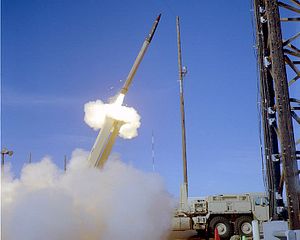The United States’ first Terminal High Altitude Area Defense (THAAD) missile defense system in South Korea reached initial operating capability (IOC) on Monday, according to U.S. Forces Korea.
Col. Rob Manning, a spokesperson for U.S. Forces Korea, told the Diplomat that THAAD “is operational and has the ability to intercept North Korean missiles and defend the Republic of the Korea.”
The activation of the system in South Korea’s North Gyeongsang province, in Seongju County, comes eight days before South Korean voters will head to the polls to elect a new president.
THAAD’s IOC status also follows a weekend of controversy sparked by remarks made by U.S. President Donald J. Trump in an interview last Friday with Reuters, where he suggested that South Korea ought to bear the approximately $1 billion cost of the system’s deployment.
Officials from both the United States and South Korea walked back that suggestion over the weekend, but not before it had raised a furor in South Korea, where the U.S.-South Korea alliance’s decision to deploy the system last year had sparked widespread protests.
A spokesperson for Moon Jae-in, the current frontrunner for the South Korean presidency, criticized the decision to deploy the system before the election, noting that the decision “ignored public opinion and due process.”
Last week, Admiral Harry Harris, the commander of U.S. Pacific Command, said the decision to deploy THAAD would “improve the alliance missile defense posture.”
“The decision to deploy THAAD to the Korean Peninsula is based solely on our commitment to defend our allies and our forces from the North Korean threat,” he added.
In addition to the domestic political controversy over the deployment in South Korea, China has long protested the alliance’s decision to deploy THAAD, citing the powerful AN/TPY-2 X-band radar that accompanies the battery.
Specifically, China may fear that the AN/TPY-2 could be deployed in forward-based mode for boost phase surveillance that could degrade Beijing’s confidence in the penetrative capability of its nuclear second-strike. China has rejected U.S. offers for technical talks over THAAD, however.
Moreover, though Beijing denies any formal sanctioning of South Korean entities in retaliation for the THAAD deployment, Lotte Group, the conglomerate that transferred land to allow for the THAAD system’s emplacement in Seongju County, has faced targeted scrutiny in China, with at least 23 of its stores in the country being shut down.
Given THAAD’s primary mission on the Korean peninsula — to detect and destroy North Korea medium- and short-range ballistic missiles — it is likely that the AN/TPY-2 radar would be configured in what’s known as terminal mode.
The radar’s terminal mode configuration would allow it to “detect, acquire, track and discriminate ballistic missiles in the terminal (descent) phase of flight,” according to Raytheon, the system’s manufacturer.
Upon the radar’s acquisition of targets, the THAAD battery would fire hit-to-kill interceptor missiles. The interceptors are capable of striking targets up to a maximum altitude of 150 kilometers and a maximum range of 200 kilometers.
THAAD, however, would not be capable of intercepting a North Korean intercontinental ballistic missile and remains untested against intermediate-range ballistic missiles.

































